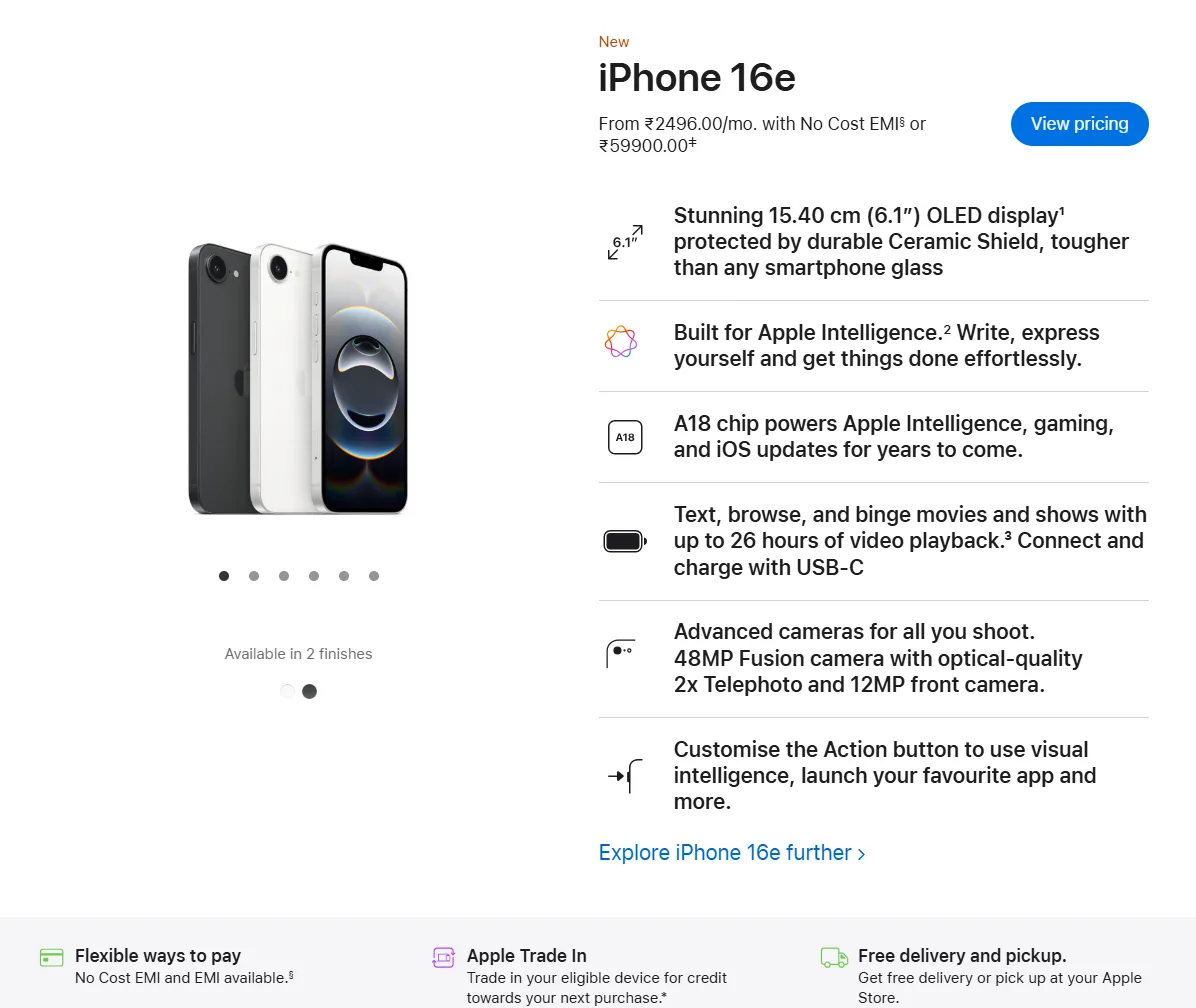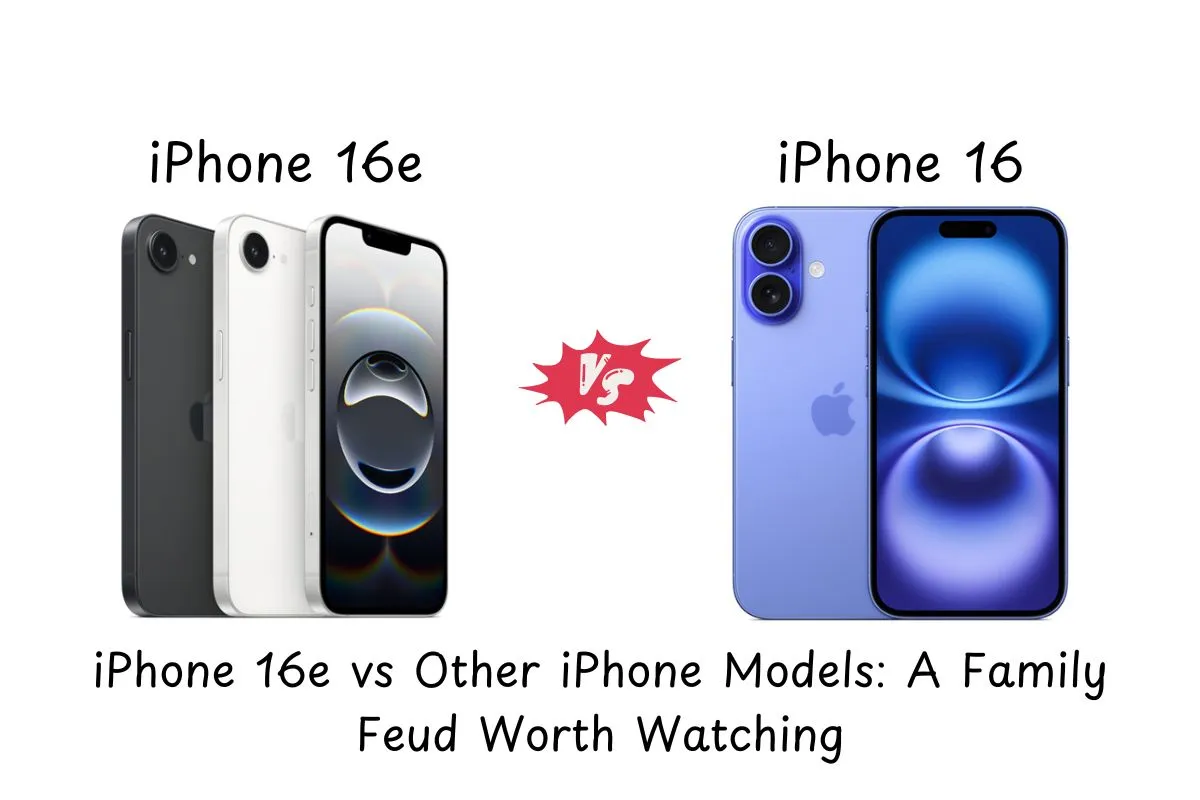“Who Wears the Crown? iPhone 16e Battles Its Siblings for Supremacy!”
Now that we’ve sized up the iPhone 16e against its Android rivals, let’s zoom in on how it stacks up against its Apple kin. The iPhone lineup in early 2025 includes the iPhone 16, iPhone 15, iPhone 16 Pro, and the recently discontinued iPhone 14 (still floating around in secondary markets). With the iPhone 16e shaking things up as Apple’s newest “budget” option, which model reigns supreme?
Let’s break it down and argue which one makes the most sense for you.
- The Lineup Lineup: Specs at a Glance
- Head-to-Head: iPhone 16e vs Its Siblings
- The Argument: Which iPhone Makes the Most Sense?
The Lineup Lineup: Specs at a Glance
Here’s a quick rundown of the key specs for the iPhone models in play, based on the latest launches and reviews:
- iPhone 16e: $599 (₹59,900), 6.1-inch OLED (800 nits peak, 1200 for HDR), A18 chip (6-core CPU, 4-core GPU), 48MP single rear camera (with 2x Telephoto), 12MP front, 26 hours video playback, no MagSafe, no Dynamic Island (notch), USB-C, Action Button, Apple Intelligence.
- iPhone 16: $799 (₹79,900), 6.1-inch OLED (1000 nits peak, 2000 for HDR), A18 chip (6-core CPU, 5-core GPU), 48MP main + 12MP Ultra Wide rear, 12MP front, 22 hours video playback, MagSafe, Dynamic Island, USB-C, Action Button, Camera Control, Apple Intelligence.
- iPhone 15: $699 (₹69,900 still available in Indian market), 6.1-inch OLED (Dynamic Island, 2000 nits peak), A16 chip, 48MP main + 12MP Ultra Wide rear, 12MP front, 20 hours video playback, MagSafe, USB-C, no Action Button, Apple Intelligence (limited).
- iPhone 15 Pro: $750 (around ₹65,000 as of late 2024, now overshadowed), 6.1-inch OLED (120Hz ProMotion Display, Dynamic Island) A17 Pro chip, 48MP wide + 12MP Ultra Wide + 12MP 3x telephoto and 12MP front camera. A titanium frame (lighter and more durable than aluminum), full MagSafe support with faster 15W wireless charging, USB-C, Action Button, and Apple Intelligence.
- iPhone 16 Pro: $999 (₹119900), 6.3-inch OLED (ProMotion, 2000 nits peak), A18 Pro chip, 48MP main + 48MP Ultra Wide + 12MP Telephoto rear, 12MP front, 23 hours video playback, MagSafe, Dynamic Island, USB-C, Action Button, Camera Control, Apple Intelligence.
- iPhone 14 (discontinued but relevant): $599 (originally), 6.1-inch OLED (notch, 1200 nits peak), A15 chip, 12MP main + 12MP Ultra Wide rear, 12MP front, 20 hours video playback, Lightning port, no Apple Intelligence.
The iPhone 16e slots in as the cheapest new option, but is it the smartest pick? Let’s dig deeper. (There is no point discussing the Plus and Pro Max models here.)
Head-to-Head: iPhone 16e vs Its Siblings
iPhone 16e vs iPhone 16: $200 Less, But at What Cost?
The iPhone 16 is the iPhone 16e’s direct sibling, and the $200 price gap is the headline act. Both share the A18 chip, 6.1-inch OLED, and Apple Intelligence, but the 16e sacrifices one GPU core, MagSafe, the Ultra Wide camera, Dynamic Island (reverting to a notch), and Wi-Fi 7. It wins on battery life (26 vs. 22 hours) and keeps the Action Button, but misses out on the Camera Control button and brighter display (800 vs 2000 nits).

Display Specifications
The display is a key area of difference, as shown in the following table:
| Feature | iPhone 16e (2025) | iPhone 16 (2024) |
|---|---|---|
| Display Type | Super Retina XDR OLED | Super Retina XDR OLED |
| Display Size | 6.1-inch | 6.1-inch |
| Notch/Dynamic Island | Notch | Dynamic Island |
| Max Brightness (typical) | 800 nits | 1,000 nits |
| Peak Brightness (HDR) | 1,200 nits | 1,600 nits |
| Peak Brightness (outdoor) | – | 2,000 nits |
| Minimum Brightness | – | 1 nit |
The iPhone 16’s display is brighter and more versatile, particularly for outdoor use, which may appeal to users needing better visibility in sunlight.
Performance and Chipset
The A18 chip powers both phones, but there are differences in GPU and modem:
- iPhone 16e: A18 chip with 4-core GPU, Apple C1 modem (first in-house modem by Apple).
- iPhone 16: A18 chip with 5-core GPU, Qualcomm Snapdragon X75 modem, supporting Wi-Fi 7 and Thread connectivity.
The performance difference is minimal for most users, but the iPhone 16’s additional GPU core may benefit graphics-intensive tasks, as noted in Mashable Comparison Article.
Camera System
The camera is a significant differentiator, as detailed below:
| Feature | iPhone 16e (2025) | iPhone 16 (2024) |
|---|---|---|
| Main Camera | 48MP Fusion, 26mm, f/1.6, Optical IS | 48MP Fusion, 26mm, f/1.6, Sensor-shift IS |
| Ultra Wide Camera | – | 12MP, 13mm, f/2.2, 120° FOV |
| Telephoto/Zoom | 2x optical zoom | 2x optical zoom in, 0.5x out, 4x range |
| Additional Features | Portrait mode with Depth Control | Next-gen portraits, Macro, Spatial photos/videos, Cinematic mode (4K Dolby Vision at 30 fps), Action mode |
The iPhone 16’s dual-camera system offers more versatility, particularly for wide-angle shots and advanced video recording.
Battery and Charging
Battery life and charging options also vary:
| Feature | iPhone 16e (2025) | iPhone 16 (2024) |
|---|---|---|
| Battery Life (video playback) | 26 hours | 22 hours |
| Wireless Charging | Qi up to 7.5W | Qi2 up to 15W, MagSafe up to 25W |
| MagSafe Compatibility | – | Yes, with cases, wallets, chargers |
Surprisingly, the iPhone 16e offers longer battery life, which may be due to its power-efficient design and the new Apple C1 modem, as mentioned in Apple Insider Comparison.
Who Wins? If you’re a power user or photographer, the iPhone 16’s extra features—like the Ultra Wide lens and Dynamic Island—justify the splurge. But for casual users who prioritize battery life and don’t mind the notch, the 16e is a steal at $599.
iPhone 16e vs iPhone 15: Old Guard Meets New Blood
The iPhone 15, still available but now overshadowed, costs $100 more than the 16e but offers the A16 chip, Dynamic Island, and MagSafe. It lags behind in processing power (no A18) and battery life (20 hours), and lacks the Action Button. The 16e’s single camera is a step up from the 15’s dual setup in resolution (48MP vs 12MP main), but it misses the Ultra Wide.
Who Wins? The iPhone 15 makes sense if you already own one and want to upgrade within the ecosystem, but for new buyers, the 16e’s newer chip, better battery, and USB-C make it a better deal. The 15 feels like yesterday’s news.
iPhone 16e vs iPhone 15 Pro: Budget Brawler Challenges The Old Powerhouse
The iPhone 15 Pro, still available but now overshadowed, costs $150 more than the 16e but offers the A17 Pro chip, Dynamic Island, and MagSafe. However, the A18 chip is slightly better in terms of performance and battery life (26 hours), and lacks the Action Button. The 16e’s single-camera setup is no match for the iPhone 15 Pro’s triple-camera setup which is more versatile.
Who Wins? The iPhone 15 Pro makes more sense for its superior feature set, especially if you can find it close to the 16e’s price in the market. However, the iPhone 16e takes the crown for value at $599, offering a compelling mix of modern tech and longevity for budget-conscious buyers. Your choice depends on whether you prioritize cost savings (16e) or premium capabilities (15 Pro).
Checkout Detailed Comparison: iPhone 16e vs iPhone 15 Pro
iPhone 16e vs iPhone 16 Pro: Dream Big or Save Big?
The iPhone 16 Pro is in a different league, starting at $999 with a bigger, brighter screen, A18 Pro chip, triple-camera system, and ProMotion. The 16e can’t compete on raw power or camera versatility, but it’s $400 cheaper and still packs Apple Intelligence and a solid 48MP camera.
Who Wins? Pro users—videographers, gamers, or those who need the best—should go for the 16 Pro. Everyone else should stick with the 16e for its balance of cost and capability.
iPhone 16e vs iPhone 14: Legacy vs Leap
Before Apple axed the iPhone 14, it was a direct competitor to the 16e at the same $599 price point. The 14 has a dual-camera system (12MP main, 12MP Ultra Wide), but its A15 chip, Lightning port, and lack of Apple Intelligence make it feel dated. The 16e’s A18, USB-C, and longer battery life (26 vs. 20 hours) are clear upgrades, even if it loses the Ultra Wide.
Who Wins? If you find a discounted iPhone 14, it’s a decent backup, but the 16e is the future-proof choice for anyone wanting modern features.
The Argument: Which iPhone Makes the Most Sense?
Here’s the million-dollar question: which iPhone should you buy in 2025? It depends on your needs, budget, and loyalty to Apple’s ecosystem. Let’s break it down:
- For Budget-Conscious Apple Fans: The iPhone 16e is your golden ticket. At $599, it delivers flagship-level performance (A18, Apple Intelligence) and battery life (26 hours) without breaking the bank. It’s perfect if you don’t need pro-level cameras or fancy charging options like MagSafe. Posts on X and reviews suggest it’s a “no-brainer” for anyone upgrading from older SE or 14 models, but some criticize its lack of an Ultra Wide lens and Dynamic Island as compromises too steep for the price.
- For Power Users and Creatives: The iPhone 16 or 16 Pro is where it’s at. The iPhone 16 adds $200 for features like the Ultra Wide camera, brighter display, and Dynamic Island, making it ideal if you value photography or a premium experience. The 16 Pro, at $999, is overkill unless you need top-tier performance, a bigger screen, or advanced video tools. YouTubers like MKBHD argue the 16 Pro is “future-proof,” but the price jump might not be worth it for most.
- For Ecosystem Loyalists on a Tight Budget: If you’re already deep in Apple’s world (AirPods, MacBooks, etc.), the iPhone 16e bridges the gap between affordability and integration. It supports Apple Intelligence, USB-C, and the Action Button, keeping you connected without the flagship cost. The iPhone 15 might tempt you at $699, but its older chip and shorter battery life make the 16e a smarter long-term pick.
- For the Nostalgic or Deal Hunters: If you can snag a used or discounted iPhone 14, it’s not a bad fallback, especially if you don’t care about Apple Intelligence or the latest chips. But given its discontinuation and inferior specs, the 16e is the clear evolution.
Final Verdict: For most people in 2025, the iPhone 16e makes the most sense. It’s Apple’s best attempt yet at a true mid-range phone, balancing cost, performance, and features. It’s not perfect—those missing features (MagSafe, Ultra Wide) sting—but the $599 price, A18 power, and 26-hour battery life outweigh the cons for casual users. But wait, don’t forget the camera. If you’re a pro or need every bell and whistle, spring for the Pro variants. But for the masses? The 16e is the sweet spot Apple’s been chasing. One must not forget the Android ecosystem. There are a plethora of options available in the market including the upcoming Google Pixel 9a.
You can also wait for the discounts and holiday seasons which might make it a more affordable and worthy buy.
For more news about upcoming smartphones and popular products, and recommendations follow us on Facebook, Instagram, and Twitter.
Some of the links on our website are affiliate links. This means that if you click on these links and make a purchase, we may earn a small commission at no additional cost to you. These commissions help us maintain and improve our website, enabling us to keep delivering valuable content to you.




